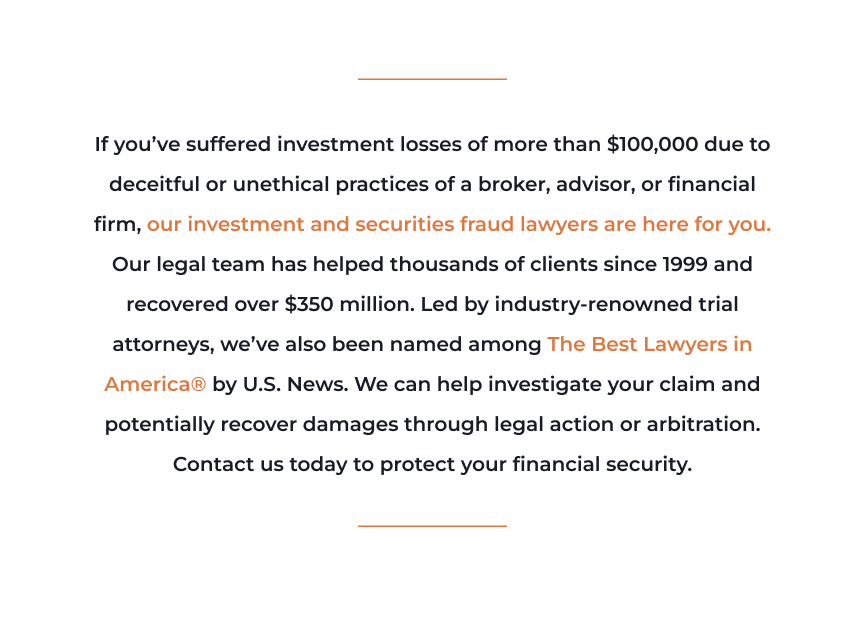
Losing money to a form of investment fraud like churning can be devastating. Fortunately, with the help of a churning (excessive trading) lawyer, you can pursue compensation for the losses you’ve suffered. No matter how serious your case is, the team at Meyer Wilson Werning can help you fight for the best results possible.
Our firm has over 75 years of combined experience recovering client losses against the largest, strongest investment firms in the nation. We are devoted to serving victims of investment fraud and misconduct. We have helped clients recover over $350 million. Reach out to our investment fraud lawyers to get the help you need to move past this difficult time.
What Is Churning?
Churning in the context of investments refers to excessive and unnecessary trading activity by a financial professional in a brokerage account. The motivation behind churning is to generate increased transaction fees and commissions for the broker rather than to benefit the investor.
When a broker engages in churning, they excessively buy and sell securities in a customer’s account with one goal in mind: generating commissions for their own benefit. It is illegal, as financial experts have a fiduciary duty to put the interests of their clients before themselves.
According to the U.S. Securities and Exchange Commission, churning is an illegal activity that violates numerous laws. The Financial Industry Regulatory Authority (FINRA) also has rules to prevent excessive trading for broker gain. If you suffered losses in your portfolio due to churning, a churning (excessive trading) lawyer can work hard to hold the advisor responsible.
We Are The firm other lawyers
call for support.
How Brokers Try to Hide Churning
One of the ways financial advisors try to mask churning is by making sure that the investment objective for the brokerage account has been marked “speculation” with a “high” or “aggressive” risk tolerance. Then, when the account is excessively traded, the advisor often argues that the customer was willing to take those risks and that active trading is what the customer requested.
However, under the rules governing the securities industry, brokerage firms must be able to demonstrate that the recommended trading strategies are in the best interests of a particular customer. In cases where an account has clearly been churned, the activity is not in the best interest of the investor, regardless of their objectives.
Even if they have an aggressive risk tolerance, no customer ever agrees or asks for their account to be manipulated solely for the purpose of deriving profits for the broker. A skilled churning (excessive trading) attorney can offer further information on how brokers hide churning and what you can do to recover your losses.
How to Tell If Your Account Is Being Churned
In some cases, you can tell if your account is being churned by reviewing your account statements and seeing if there is excessive buying or selling. That said, to mask churning, brokers will hold on to the investments in your account that perform poorly while selling off those that are profitable.
That way, your portfolio will appear to be performing well due to the gains you see each time a profitable investment is sold. Unfortunately, you are actually losing money on frequent commissions and poorly performing investments. Warning signs of churning and other forms of broker misconduct include:
- Excessive trading activity
- High turnover rate
- Unsuitable investments
- Lack of communication
- Unexpected fees and commissions
- Poor performance
- Lack of diversification
If you notice any of these red flags, contact our experienced churning (excessive trading) attorneys as soon as possible. We’ll investigate your losses and gather the evidence we need to hold the offending financial advisor or brokerage firm accountable.
We Have Recovered Over
$350 Million for Our Clients Nationwide.
How Is Churning Proven?
Excessive trading is typically determined by evaluating your account’s break-even or cost-equity ratio, which measures the annual cost you incur from an investment strategy and annual turnover rate. Typically, an annualized turnover ratio of 4 or higher is excessive but other ratios may also be excessive, depending on the circumstances.
Meyer Wilson Werning works with the industry’s best forensic accounting experts to analyze your portfolio for excessive trading. This collaborative effort highlights our dedication to providing effective solutions for investors. Reach out to our team today to schedule a free consultation with a churning (excessive trading) attorney and learn more about how to prove churning.
Our lawyers are nationwide leaders in investment fraud cases.
Bringing a Churning Claim to Arbitration
Most negligence and fraud claims are resolved through FINRA arbitration. The arbitration process involves a neutral panel of arbitrators who review evidence, hear arguments, and make binding decisions on the dispute. FINRA arbitration is known for its efficiency and focus on financial matters, providing a quicker and more cost-effective alternative to court proceedings.
The arbitration panel will consider the following aspects before making a final decision:
Turnover
Turnover refers to the dollar amount of opening buy transactions as compared to the average net worth or equity of the portfolio. The general rule of thumb is that if your portfolio has a turnover ratio of 400% or four times the average net worth of the account, then churning most likely took place. This calculation is one of the most important factors in these claims.
Control
Another key element is who was in control, meaning the person who decided what to buy and sell, how much, and when to do it. To have a successful arbitration claim, your churning (excessive trading) lawyer must show that your broker or advisor controlled and directed the trading activity in your account.
Commissions and Fees
The commissions and fees incurred through the trading activity will also be reviewed during arbitration. If you experienced disproportionately high transaction costs compared to the potential benefits of the trades, it could strengthen your case.
Documentation
The availability and accuracy of documentation play a crucial role in arbitration. Comprehensive records, including account statements, communication with the broker, and documentation of investment discussions, can serve as valuable evidence to support or refute a churning claim.
Breach of Fiduciary Duty
The arbitration process may also explore whether there was a breach of fiduciary duty on the part of the advisor. If a financial advisor breach of fiduciary duty lawyer can demonstrate that the advisor failed to act in your best interest, it will strengthen your claim.
How Churning (Excessive Trading) Lawyer Can Help You
There are a number of ways that our churning (excessive trading) lawyers can help you during this challenging time. We’ll work tirelessly to get a settlement that meets your unique needs and allows you to move forward with future investments. Here’s what our team can do to make sure you get a fair outcome:
- Provide a free, no-obligation consultation
- Investigate your investment losses and gather evidence for your case
- Calculate the extent of your losses
- Guide you through the arbitration process
- Fight for the compensation you need to replace your losses
- Answer any questions you have about your case
- Explain what churning is and how to identify it in the future
- Represent your best interests throughout the entirety of your case
As you can see, there are many actions a lawyer can take to help you recover your investment losses. With an experienced attorney by your side, you’ll have an excellent chance at receiving comprehensive compensation for your losses. Schedule a free consultation today to take the first step towards your settlement.
You Need Meyer Wilson Werning for Your Investor Claim
At Meyer Wilson Werning, our dedicated team of attorneys has the skills, experience, and resources necessary to recover your investment losses. We have helped clients from all over the country receive hundreds of millions of dollars for lost assets.
Our investment fraud lawyers will evaluate your account’s cost-equity ratio and turnover rate to identify any signs of broker misconduct. If your advisor engaged in negligent acts or fraud, we will help you hold them accountable. Contact us today to schedule a free consultation with a churning (excessive trading) lawyer to get started on your case.
Recovering Losses Caused by Investment Misconduct.



